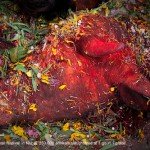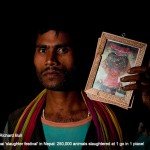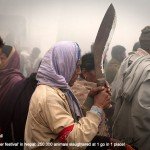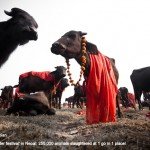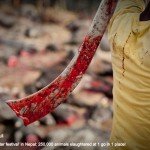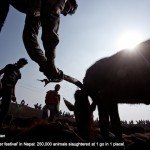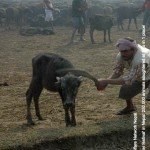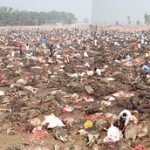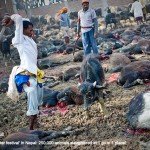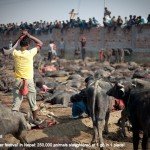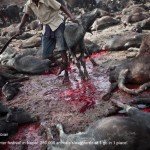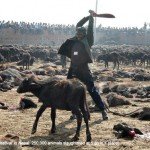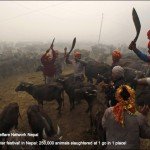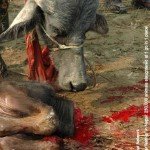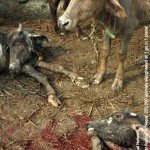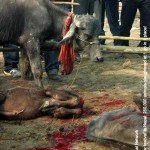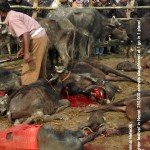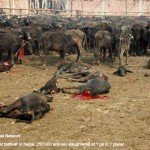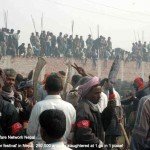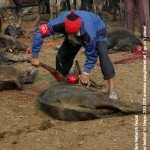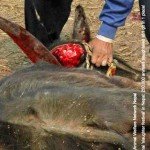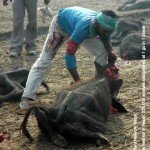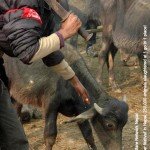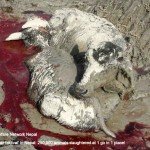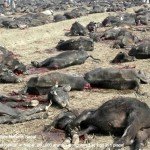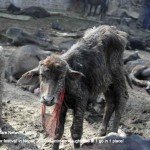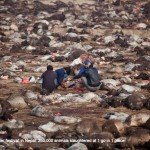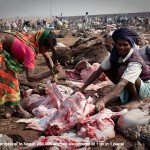Sources of the text and pictures: Gadhimai Festival on Wikipedia, Enrico Fabian’s eyewitnes account of Gadhimai 2009, Richard Bull’s eyewitness account of Gadhimai 2009
Gadhimai Mela is considered the biggest single animal sacrifice on our planet. This centuries-old tradition is observed every five years in Gadhimai premises located in the village of Bariyapur of Bara District of Nepal near the border with India. In the 2009 ‘festival’ at between 250,000 – 500,000 animals were sacrificed. The next Gadhimai Mela will be in 2013!
About 5 million people participate in the festival, the majority of whom are Madheshi people from the Indian states of Uttar Pradesh and Bihar & Terai. Attending the festival in Nepal circumvents the ban on animal sacrifice in their own states.
A sister of the goddess Kali, Gadhimai is supposed to have the power to fulfill wishes and augur good luck and prosperity. As in most parts of life, nothing comes for free and a certain duty has to be fulfilled to receive something in return. The duty in this case is the sacrifice of hundreds of thousands of animals.
A month before the ritual in 2009, the Nepalese government realized there would be a “severe shortage” of goats for the ritual sacrifice, as well as for the consumption of goat meat during the festival. They began a radio campaign urging farmers to sell their animals!
Eyewitness account of Enrico Fabian, November 2009:
The devotees arrive days or even weeks before the main day of the festival and begin setting up their small tents on the harvested paddy fields. They bring with them their essentials and the sacrificial animals, such as pigeons, goats, sheep, pigs and buffaloes. These animals are meant for one purpose only, to be sacrificed to the goddess Gadhimai. Most of the families covered vast distances to take part in this religious occasion and so thousands of believers crossed the Indian border into Nepal to participate in this rare mela. The animals they brought along not only cause a logistical problem, but also a financial one. Most of the families are poor and cannot even afford to spend a single Rupee carelessly. Some of them put themselves into high debts just to buy an animal and thus be able to contribute to the sacrifice.

After slaughtering an animal the blade is wiped on the its belly to remove the blood and before the next one is slaughtered
During the days before the sacrifice the animals have to stand in the open while the daytime temperatures are very high and nights very cold. No kind of shelter, water or any food is available to the animals. The young and weak ones did not even survived the first nights in the open. Animals laying on the ground fighting for their lives where scrunched by their clueless relatives. The animals which were still able to walk after the torture of the last days, will stand in the compound watching how one after the other of their kind was beheaded. After the beheading it sometimes took over 10 minutes until the last sign of live left the oppressed bodies of the animals.
Buffaloes are considered the most valuable offering to the goddess and thousands were brought along by the pilgrims. The buffaloes were pent-up in a compound the size of two football fields, surrounded by a brick wall – unaware of their destiny, their inescapable fate. Many of the buffaloes, already weakened by the long journey that lay behind them, died from exhaustion, starvation or dehydration. The compound did not offer shade, water or food for them.
During these days before the main sacrifice, hundreds of thousands of people throw pigeons on the pagoda-style roof of a temple next to the goddesses’ shrine. The pigeons piled up until all of the three temple canopies bulged with pulsating masses of feathers. The dead ones were lying beneath the living. After this, devotees rang huge copper bells, offered Prasada (Hindi for a sacred gift) and received blessings from the goddess.
During the opening ceremony at the tree temple the main priest sacrifices two pigeons, a goat, a sheep and a field rat by cutting off their heads. As the first buffalo head was separated from the animal’s body by a powerful whip with the blade, thousands of spectators cheered and threw their hands into the air. Seven more were sacrificed and devotees elbowed their way through the masses to tip their forefinger into the fresh blood, flowing out of the still twitching bodies.
After this the butchers forced their way through the vast pile of people, who were left behind after the rusty metal doors to the buffalo compound got closed, leaving the spectators outside. The ones who had entered the compound were the ones responsible for fulfilling the purpose of the donated buffaloes. The mela committee selected them in advance because of their knowledge in killing animals in a proper and fast way, by chopping of their heads, ideally with a single powerful blade whip.
What happened in the next ten hours was an indescribable sight of around 150 men chopping of the heads of around 15-20,000 buffaloes. Minute by minute, one after the other, the buffaloes collapsed as their head was severed from their body. Some of the men carrying out this duty were congratulating each other for the clean execution, cheerful about what they had done.
Police officers, the persons responsible for the compound, the ones who brought a buffalo and the ones who climbed the surrounding brick wall had been the only witnesses of this scenery. Within seven to eight hours most of the twenty thousand buffaloes had been killed by death through beheading, called Jhatka. The scenery was filled with quivering buffalo bodies without heads, eye twinkling buffalo heads without bodies and men looking for the next oblation. At the end of the day only a few weak buffaloes, which had just been forgotten, laid in between their slaughtered relatives.
At the end of the day, the dried out soil of the compound was blood red, soaked with all the fluids flowing out of the dead animals’ bodies. Amongst them the butchers carried their blood dripping blades in search for the last buffaloes alive; none of them should be forgotten. To please the mighty goddess Gadhimai, in the hopes of getting their prayers fulfilled, the buffalo heads would later be buried in front of the tree temple where the whole procession initially started.
While the sacrifice of the buffaloes wasn’t a proper public sight, the next day reserved for the sacrifice of goats, sheep and pigs brought something different. All over the temple complex and especially in front of Gadhimai’s shrine countless smaller animals were brought to death in the same way the buffaloes had been, by decapitation. The whole area took the appearance of a bizarre, colorful and overly crowded slaughterhouse. People were dancing and singing, priests gave their blessings to the devotees, people took a bath in the nearby lake and police officers tried to keep the huge amount of pilgrims under control.
On the other side of the complex, people from the nearby villages started to take whatever was still usable from the buffaloes, whose dead bodies had been lying in the sun since almost a day. The fume rising from the dead animal bodies was overwhelming but nobody seemed to be overly bothered by it. Cutting their way through the bloated corpses they took the meat for drying in the open, as well as the skin for producing leather.
Within the main days of the mela at least 200,000 animals had been sacrificed and the demands of the goddess Gadhimai had been fulfilled. The devotees broke down their temporary homes and started their journey back home, confidently that their wishes and prayers would be heard.
- The 1st cut
- The goddess Gadhimai
- The ‘official butchers’ enter the buffalo arena
- One of the official butchers at Gadhimai
- A young buffalo still decorated with offers of devotes stands amongst his relatives.
- After slaughtering an animal the blade is wiped on the its belly to remove the blood and before the next one is slaughtered
- With one powerful blow of his blade a devotee severs the head of a buffalo.
- A buffalo observes the carnage
- This is an ad-hoc slaughter in the background the boundary of the coral can be seen with the early morning spectators
- The Gadhimai buffalo slaugher corral
- The buffalo’s don’t in general try to run or fight. This is not tiger hunting.
- Finding the next kill
- One of the butchers taking part in the sacrifice drags a young buffalo to the place where before him dozens of his kind lost their lives.
- The slaughter
- The slaughter begins
- A mother and son
- A family with no hope
- A mother buffalo watcher her decapitated child.. she’s next
- The carnage continues till all the buffalo’s in the holding coral have been butchered
- The carnage continues till all the buffalo’s in the holding coral have been butchered
- A government managed, police controlled mob
- There is much jubiliation amongst the butchers for ‘clean kills’
- Not one of them
- This ones’ done for
- This young buffalo’s next
- Rivers of blood would not slake the thirst of ‘centuries of tradition’
- The killing field
- One of the stragglers, a butcher will find him soon
- Gadhimai Mela – the end of the slaughter
- A family takes away some meat the next day













